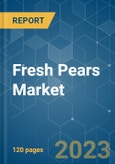Key Highlights
- Pears contain special phytonutrients, including anti-inflammatory flavonoids, anticancer polyphenols, and anti-aging flavonoids. Pear is one of the best sources of vitamin C, vitamin K, and boron. It can help lower inflammation, which is the root cause of most diseases. Thus, the benefits of this fruit have, in turn, driven its consumption, majorly across the United States. The increasing health consciousness and the increasing demand for organic fruits act as the major driving forces behind the growth of the fresh pears market.
- The Japanese government is looking to export to various markets, the pear industry in particular, as domestic consumption is set to decrease with a declining population, so the country is aiming to expand its annual agriculture exports by 2030.
- The sales have been high in supermarkets and health food stores, targeting upscale consumers with specialized eating habits. According to FAOSTAT, global pear production accounted for 25.6 million metric tons last year, with a harvested area of 1.3 million hectares. Asia was the largest pear-producing region, with a production of 20.8 million metric tons last year.
Fresh Pears Market Trends
Increasing Production and Per capita consumption of Fresh Pears in United States
Pears are an excellent source of fiber and a good source of vitamin C for only 100 calories per serving. They are sodium-free, cholesterol-free, and fat-free and contain 190 mg of potassium. The USDA Dietary Guidelines for American pears will reduce their risk of some chronic diseases and this makes the high demand for domestic production and consumption of pears in the country and this will strengthen the market in coming years.According to FAOSTAT, 2021, the total pear production in the United States was 636,390 thousand metric tons with a harvested area of 16,876 hectares. The United States per capita consumption of fresh pears increased from 2.92 pounds to 3.12 pounds from 2020 to 2021.
Pear is mainly produced in Washington and Oregon in the United States. Washington’s fresh pear production is the largest in the United States, accounting for half of the pear production in the country. Oregon and Washington account for 25% of pear production in the United States. Northwest pears are majorly produced in the Yakima and Wenatchee areas of Washington and the Rogue River Valley and Hood river areas of Oregon.
Although finding adequate labor is a major concern and the cost associated with the labor is also high. As a result, modern techniques of farming are utilized, including GPS and variable rate technologies, for fertilizer and water applications to maintain production in the economy which will boost the market during the forecasting period.
China is the Major Exporter and Producer
China is the largest producer and exporter of pears in the world. With the gradual rise in temperatures, China's pears entered their period of peak sales and were affected by the domestic stocking for the Qingming Festival and overseas stocking for Muslim countries' Eid al-Fitr, the demand in both markets increased, leading to a slight rise in the price of fresh pears by about 10%. Merchants managed to increase sales through online and offline channels, especially with the rapid development of fresh food e-commerce, consumers can buy a variety of China's fresh pears through an easy click on the platforms.According to FAOSTAT, 2021, China's fresh pear production was 18.9 million ton, and exported 510,138 ton of pears worth USD 605.4 thousand. In China, the export value has slightly declined in 2021, compared to the previous year due to the impact of the pandemic all over the world. According to the Foreign Agricultural Service (FAS) of the United States Department of Agriculture, China is anticipated to produce almost 2% higher than in the previous year. Though the drought has reduced the pear harvest in China's eastern provinces, the total production is expected to increase because of abundant harvests in other regions.
The countries with the highest levels of pear per capita consumption in 2020 were Argentina, Italy, the United States, and China. Thus, the increasing demand for pear worldwide, the market is expected to continue an upward consumption and tends to grow the market in the coming years.
Fresh Pears Industry Overview
Additional Benefits:
- The market estimate (ME) sheet in Excel format
- 3 months of analyst support
This product will be delivered within 2 business days.
Table of Contents
Methodology

LOADING...










